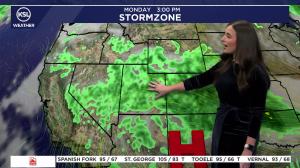Estimated read time: 2-3 minutes
This archived news story is available only for your personal, non-commercial use. Information in the story may be outdated or superseded by additional information. Reading or replaying the story in its archived form does not constitute a republication of the story.
KABUL, Afghanistan (AP) — The U.S. military has launched its first airstrikes against the Taliban in Afghanistan since President Barack Obama's decision earlier this month to expand America's involvement against the insurgents, U.S. officials said Friday.
Officials said the strikes began in the last week and were against Taliban targets in the southern part of the country. But Pentagon press secretary Peter Cook declined to provide any details, citing "operational security."
One senior U.S. official said there have been "a couple" of airstrikes, but the U.S. does not want to provide more information because there may be more strikes in that area, including missions with Afghan forces who could be accompanied by U.S. advisers.
The official was not authorized to discuss the operations publicly, so spoke on condition of anonymity.
The U.S. military spokesman in Kabul, Brig. Gen. Charles Cleveland, said U.S. forces "have conducted a limited number of strikes under these new authorities" but it is "too early to quantify the effects achieved."
The strikes "are only being used where they may help the Afghans achieve a strategic effect," Cleveland said.
U.S. officials made it clear when they announced the new authority to hit Taliban targets once again that they would only be used in selective operations that were deemed to have a strategic and important effect on the fight. Cook said the strikes "hit their intended targets."
He added the strikes were "part of an ongoing operation that, again, the goal of which would be a strategic effect on behalf of the Afghan forces that we are enabling, and that's exactly what they were intended to be used for."
Pressed for more details, Cook refused, saying "these are ongoing operations" and he does not want to be "telegraphing what's to come to the enemy."
The war in Afghanistan began in 2001, and the U.S. has been conducting a broad range of operations there ever since.
Obama decided in early June to expand America's involvement with more airstrikes against insurgents, giving the U.S. military wider latitude to support Afghan forces, both in the air and on the ground.
Since all foreign combat troops pulled out of Afghanistan at the end of 2014, leaving only an advisory and training contingent of international forces behind, the Afghan military has struggled in leading the fight against the Taliban and other militants.
The 9,800 remaining U.S. troops in Afghanistan are scheduled to drop to 5,500 by the end of this year, but the pace of that decline has yet to be decided. One factor in determining future troop levels is the extent to which NATO allies are willing to remain involved in training and advising the Afghans.
___
Associated Press writer Robert Burns in Washington contributed to this report.
Copyright © The Associated Press. All rights reserved. This material may not be published, broadcast, rewritten or redistributed.






